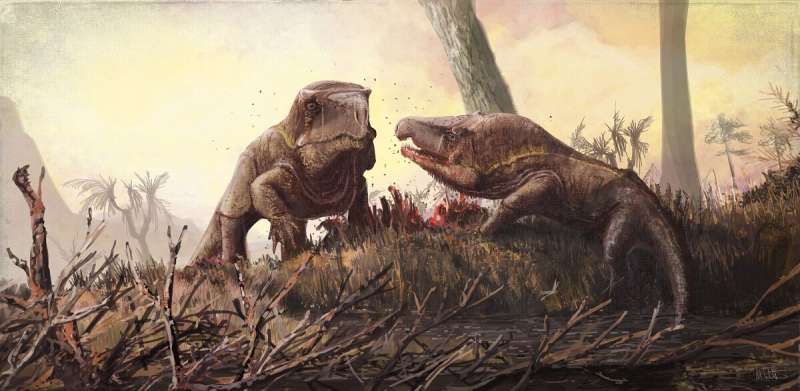November 20, 2019 report
Ancient komodo dragon-like animals had heads proportionally larger than dinosaurs

An international team of researchers has found evidence showing that the ancient meat-eating creature Vjushkovia triplicostata had a proportionally larger head than any known dinosaur. In their paper published in the journal Royal Society Open Science, the group describes their reexamination of V. triplicostata and what they learned about the large Komodo dragon-like creature.
V. triplicostata was a member of the Erythrosuchids family, which was of the clad archosauromorphs. The oldest known examples of Erythrosuchids are Garjainia, of which there are two known kinds: Garjainia prima, which has been found in South Africa, and V. triplicostata, which was found in Russia.
As a group, Erythrosuchids were known as "red crocodiles" because of their long bodies and huge, sharp teeth. They existed during the time after the Permo-Triassic mass extinction, just a few million years before dinosaurs arrived on the scene—as such, they were an apex predator. In this new effort, the researchers note that Garjainia prima has been extensively studied, but until now, little work has been conducted with V. triplicostata. To fill in the gap, the researchers took a close look at its fossilized skull.
They found that it and Garjainia prima were actually of the same species. They also found that taken together, the two had some of the largest heads, proportionally speaking, of any known reptile. They suggest the massive head likely came with equally massive muscles, which likely were useful for capturing prey. They noted also that archosauromorphs in general tended to have overly large heads compared to their body size, which they suggest was an indication of an invasion of hypercarnivorous creatures emerging after the largest mass extinction on record.
The researchers also found that both of the Garjainia creatures would have had a length of approximately 3 meters—and they would have looked similar to modern Komodo dragons. They further report that they plan to take a closer look at the V. triplicostata fossil, this time concentrating on the rest of its body, hoping to better understand why the creatures had such large heads. They expect to find that the large heads came about as their bodies grew larger in general, as part of carnivorous adaptations.
More information: Richard J. Butler et al. Cranial anatomy and taxonomy of the erythrosuchid archosauriform 'Vjushkovia triplicostata' Huene, 1960, from the Early Triassic of European Russia, Royal Society Open Science (2019). DOI: 10.1098/rsos.191289
Journal information: Royal Society Open Science
© 2019 Science X Network





















